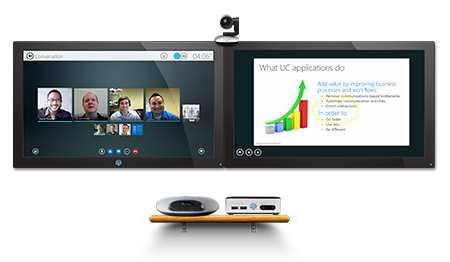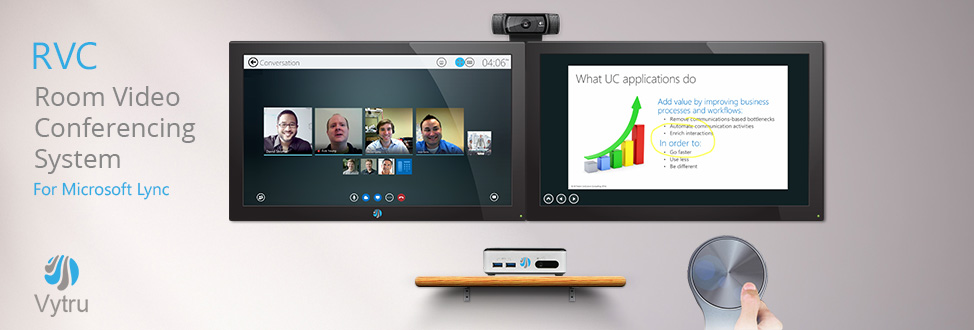In this blog post, i share my own observation of the Lync room video conferencing market in 2015. Microsoft Lync is rapidly becoming the platform of choice for organizations looking at a Unified Communications solution. Video Conferencing with Microsoft Lync is one of the features that are bringing more traction and attention to Lync. Recently, more and more organizations are thinking of bringing Lync to their conference rooms to replace the disparate, outdated video and telepresence systems in favor of a unified video conferencing experience with Lync on PC, laptop, smartphone, and tablet.
The Lync Video Conferencing Systems Market is Growing
The massive growth in demand for Lync video conferencing systems reinforces the importance of extending Microsoft Lync to the conference rooms. The impact of deploying Microsoft Lync Room Video Conferencing systems does not only increase user productivity, enhance internal and external communication, and reduce travel costs, but also it does unify the Unified Communications and Collaboration experience across the organization, and across all devices. Lync Room Systems are no longer to limited to what Microsoft and its partners have to offer, more start-ups are leveraging this market trend and are competing to win market share.
Market Solutions for Lync Interoperability with Legacy A/V Systems Is Expanding
Organizations are not willing to invest more money on interoperability hardware or software media gateways to connect their legacy video conferencing systems with their Lync infrastructure. Legacy systems in the conference room that cannot do Lync integration out of the box will not be able to make/receive calls to and from Microsoft Lync users or other Lync Room Systems. And this is when the company looks for solution to do this interoperability.
Having two disparate systems will require a lot of investment in media gateways, licensing, maintenance, and IT overhead. Organizations simply want to adopt a native Lync Video Conferencing solution to leverage their Microsoft Lync infrastructure investments and have a Lync experience in the meeting room similar to that of the PC or laptop. So, after working with temporary solutions for a while, replacing those legacy systems with Lync-enabled solutions becomes on their alternatives.
Having two disparate systems will require a lot of investment in media gateways, licensing, maintenance, and IT overhead. Organizations simply want to adopt a native Lync Video Conferencing solution to leverage their Microsoft Lync infrastructure investments and have a Lync experience in the meeting room similar to that of the PC or laptop. So, after working with temporary solutions for a while, replacing those legacy systems with Lync-enabled solutions becomes on their alternatives.
Pricing is Holding Back Organizations form Adopting Lync Room Systems
When organizations start to look for a Lync Room System solution, they are faced with two challenges. The Cost of those systems and the Integration they offer with their existing audio/video gear. These two challenges hold users back from extending Lync to their video conference rooms. The existing Lync Room Systems in the market offer an over-priced combo of Microsoft Lync Room System edition with interactive boards, webcam, and audio systems. Those systems are not ready to be customized, and are very expensive, and does not work for all rooms. Simply, one size does not fit all.
Do-It-Yourself Solution Does Not Work Well
Because of the high prices of Lync room system solutions, some users choose to go with DIY solutions and they end up with connecting a laptop or a PC to a display and use a Lync account to make video conference calls. However, those experiences don’t live up to the level of required quality of the meeting room experience because it lacks many features that a Lync-enabled conference room should have. have. Some reasons why this setup does not pretty well for everyone:
1- No fixed room identity (No specific Lync account for the room, use would use their own Lync accounts to sign in).
2- PC's OS maintenance and updates.
3- No enterprise-grade management for the DIY conference rooms since all are using dedicated PCs.
4- Some issues related to connected peripherals like camera and speakers and switching between multiple devices like those.
5- No great user experience of the desktop Lync client in the meeting room.
6- PC control is limited to one meeting participant and there must be a meeting moderator to control the meeting.
1- No fixed room identity (No specific Lync account for the room, use would use their own Lync accounts to sign in).
2- PC's OS maintenance and updates.
3- No enterprise-grade management for the DIY conference rooms since all are using dedicated PCs.
4- Some issues related to connected peripherals like camera and speakers and switching between multiple devices like those.
5- No great user experience of the desktop Lync client in the meeting room.
6- PC control is limited to one meeting participant and there must be a meeting moderator to control the meeting.
Introducing the Vytru RVC3000
RVC3000, the Room Video Conferencing system for Microsoft Lync is a Lync Video Conferencing codec that runs Vytru's full-featured software that delivers an unmatched Lync experience for the meeting room while reserving the same Lync user experience. The RVC3000 is extremely simple to setup, very easy to use, and can be customized and integrated with USB Video Cameras, USB audio systems, and a wide range of TVs, Touch Displays, or Interactive Boards. The RVC3000 Codec re-imagines "Do-IT-Yourself" by providing you with the Soft Codec that has unlimited integration and customization options. As a result, this can cut down costs of adopting Lync Room Systems pretty much by leveraging existing audio and video gear or by customizing systems that fit your needs.


 RSS Feed
RSS Feed
